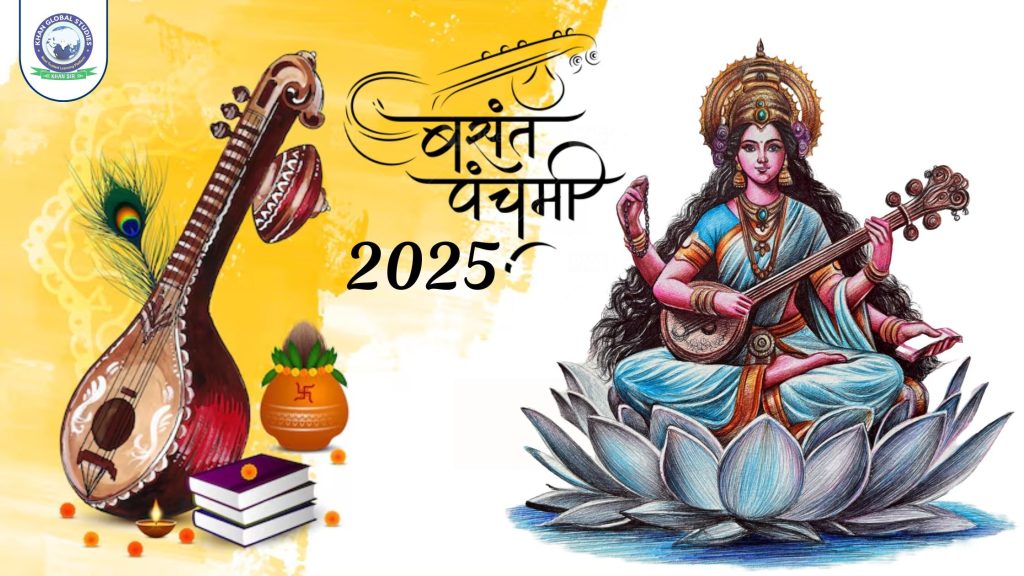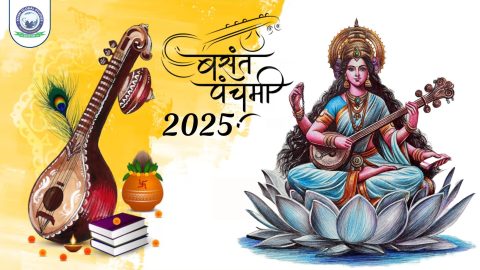Introduction to Vasant Panchami
Vasant Panchami, also known as Saraswati Puja, is a Hindu festival that marks the beginning of preparations for spring. This auspicious occasion, celebrated in India, Nepal and Indonesia, is dedicated to Goddess Saraswati, the goddess of knowledge, education and arts. The festival also marks seasonal change and begins the countdown to Holi, which falls forty days later.
Vasant Panchami 2025: Date and Celebrations
Vasant Panchami in the year 2025 will be celebrated on Thursday, February 3. The day is celebrated with great enthusiasm, especially in educational institutions and temples where Saraswati Puja is performed. Devotees wear yellow clothes, offer prayers and participate in cultural programs that highlight the importance of knowledge and education. Kite flying competitions are also held in many areas, making the day festive.
Significance of Vasant Panchami
Vasant Panchami is celebrated on the fifth day (Panchami) of the Hindu lunar month of Magha, which usually falls in late January or early February. The festival is associated with new beginnings, especially in education, arts and agriculture. It commemorates the change to warmer days, as spring is considered the king of all seasons.
Spiritual and Cultural Celebrations Across India
- Saraswati Puja: Honoring the Goddess of Wisdom
For Hindus, Vasant Panchami is primarily a day to worship Goddess Saraswati, who is believed to bestow knowledge and education. Special prayers are offered in educational institutions across India, where students place their books near the idol of Saraswati and seek blessings for academic excellence. Devotees offer yellow flowers, sweets and saffron-infused rice, as yellow is the goddess’ favourite color.
- Hate Khori and Vidya Aarambh: The First Step Towards Learning
In regions like West Bengal and Odisha, young children begin their formal education on this day in a sacred ceremony called Hate Khori (also called Vidya Aarambh or Khadi-Chuan). Parents encourage their children to write their first alphabet, which symbolizes a lifelong journey of knowledge.
- Kite Flying: A Traditional Celebration
One of the most vibrant traditions associated with Vasant Panchami is kite flying, especially in Punjab, Rajasthan and Gujarat. The skies fill with colorful kites, symbolizing joy and freedom, and people participate in friendly kite-flying competitions.
- Vasant Panchami and Kamadeva: Festival of Love
In some traditions, Vasant Panchami is associated with Kamadeva, the Hindu god of love, and his wife Rati. Legend has it that sages sought Kamadeva’s help to awaken Lord Shiva from deep meditation so that he could unite with Goddess Parvati. This aspect of the festival makes it a day of love, romance, and passion.
Regional Celebrations of Vasant Panchami
North India: A Grand Spectacle
- In Uttar Pradesh, Madhya Pradesh, and Bihar, people worship Shiva and Parvati, offering mango flowers and wheat ears that symbolize a rich harvest.
- Prayagraj hosts a grand fair, with thousands of devotees taking a holy dip in the River Ganges.
West Bengal and Assam: Saraswati Puja Celebrations
- For Bengalis, Saraswati Puja is one of the most important festivals, with grand altars dedicated to the goddess being built in homes and schools.
- Traditional Bengali sweets like khichdi, laddoos, and mishti doi are made and distributed among family and friends.
Odisha: Day of learning and rituals
- In Odisha, this festival is known as Basant Panchami, and schools perform homas and yagnas to seek divine blessings.
- Children participate in Vidya Aarambh, which marks the beginning of their educational journey.
Punjab: Kite festival of Basant
- In Punjab, Basant Panchami is synonymous with the Basant Mela, where people fly kites and enjoy music, dance, and traditional feasts.
Maharashtra and Gujarat: Festival of colours
- In Maharashtra, newlywed couples visit temples for blessings, while in Gujarat people wear yellow clothes and make saffron rice.
Indonesia and Bali: Hari Raya Saraswati
- In Bali, Hari Raya Saraswati marks the beginning of their 210-day Pawukon calendar. Families and students pray at the temple, and schools hold special cultural events.
Symbolism of Yellow in Vasant Panchami
The color yellow plays an important role in Vasant Panchami celebrations. It represents energy, wisdom, and prosperity. Devotees wear yellow clothes, offer yellow flowers, and prepare dishes like kesari (sweet saffron rice), kesari halwa, and besan laddus.
Traditional Rituals performed on Vasant Panchami
- Saraswati Puja – Idols of Goddess Saraswati are decorated with yellow color and worshipped in homes, temples, and schools.
- Kite flying – A popular tradition in northern and western India.
- Educational celebrations – Haate Khori to mark the beginning of children’s education.
- Yellow apparel and food – Devotees wear yellow clothes, and the food includes saffron rice and sweets.
- Shiva-Parvati Puja – Special worship of Lord Shiva and Goddess Parvati is performed in Maharashtra and Uttar Pradesh.
Conclusion
Vasant Panchami is a vibrant festival that beautifully blends spirituality, culture and seasonal change. Be it Saraswati Puja, kite flying or love rituals, this festival holds great significance in the Hindu tradition. It is a day of learning, happiness and new beginnings, celebrated enthusiastically across various regions of India and beyond.
Frequently Asked Questions (FAQs)
Q: What is the significance of Vasant Panchami?
Answer: Vasant Panchami marks the advent of the spring season and is dedicated to Goddess Saraswati, the goddess of knowledge, wisdom and education.
Q: When will Vasant Panchami be celebrated in the year 2025?
Answer: Vasant Panchami in the year 2025 is on Thursday, February 6.
Q: Why is the main color of Vasant Panchami yellow?
Answer: The yellow color symbolizes energy, knowledge and prosperity. It is associated with the goddess Saraswati and the mustard fields that bloom during spring.
Q: What are the traditional foods eaten during Vasant Panchami?
Answer: People make and enjoy kesari (sweet saffron rice), kesar halwa, besan laddus and other yellow-coloured dishes.
Q: How is Vasant Panchami celebrated in different regions?
Answer: The festival is celebrated across India in the form of Saraswati Puja, kite-flying, Vidya Aarambh (beginning of education) and Shiva-Parvati Puja.




